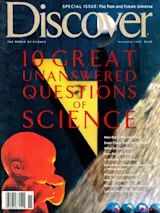Reconstructing the events that got prehistoric humans all over the globe is like keeping a litter of puppies in a basket. Every time order seems imminent, some crucial element wriggles away.
The potential chaos has different guises. Sometimes a new laboratory technique upends the conventional wisdom, then is itself upended. Sometimes a new archeological site rattles an old timetable, then slinks, invalidated, into obscurity. Sometimes a specialist from another discipline looks at the problem and says, in effect, Sorry to be a nuisance, but according to what we know in our department, your solution can’t possibly be right.
All these things, and more, have happened in the last decade. Brush fires--to change metaphors--have flared on every continent.
For Old World prehistorians the heat has been fairly intense for the past five or six years. At issue has not been whether the earliest hominids evolved in Africa 3 million to 4 million years ago: fossils have made that, by now, beyond debate. Nor has there been any question that a subset of those hominids (in the shape of heavy-browed Homo erectus) left Africa about a million years ago; hand axes and fossils scattered throughout the Old World prove they were there. The mystery is whether those Homo erectus populations gave rise to us. That is, it’s a mystery unless you ask Milford Wolpoff. This is no mystery, says the University of Michigan paleoanthropologist happily. This thing is solved.
The background to his contentment is as follows. For years Wolpoff had been studying Homo erectus, confident--as were many others in the field--that it was H. erectus who established the human beachhead in the temperate zone, H. erectus who gave rise, more or less, to modern European, Middle Eastern, and Asian populations.
That commonsense scenario--European H. erectus evolving into modern Europeans, Asian H. erectus into modern Asians--was badly shaken in 1987. That was when several biochemists from the University of California at Berkeley presented the phenomenon called mitochondrial Eve, in a six- page paper in Nature that abruptly turned the Old World evolutionary debate on its head. The research team, led by the late Allan Wilson, based its conclusions on genes, not bones, and asserted that there had been not one but two radiations out of Africa. The first was indeed by Homo erectus, but that one apparently didn’t take. It was the second radiation--at about 200,000 years ago--that counted; those emigrants were our ancestors. They displaced the previous tenants by fair means or foul, did not interbreed with them, and thus could rightfully lay claim to the title of ancestral person.
In a trice Eve became the hottest new evolutionary player since Lucy--that is, Australopithecus afarensis, the oldest upright human ancestor we have evidence of--and H. erectus became a footnote. Wolpoff, convinced that the fossil record provided no support for the paleoinvasion envisioned by the Berkeley group, picked up the cudgels and became H. erectus’s point man, defender of the fossil faith.
The Berkeley biologists based their startling conclusion on an examination of the DNA in mitochondria. Mitochondria are a cell’s energy factories; every human cell contains them, and every mitochondrion contains its own bit of DNA. However, your mitochondrial DNA (mtDNA) differs from the DNA in the nucleus of your cells in one essential respect: you got all of it from your mother. When an egg is fertilized, the sperm’s tiny mitochondrion is reabsorbed; thus all of us--male and female--contain exclusively maternal mtDNA.
Because mtDNA doesn’t undergo mixing, the differences between, say, your mtDNA and that of your great-grandmother will be due to the accumulation of mutations. Most researchers believe that mutations pile up in the mtDNA of all organisms with an average statistical regularity; this is the so-called molecular clock. All else being equal, the genetic distance between you and your third cousin--or between the average human and the average chimpanzee--is a measure of how long ago each pair shared a common ancestor. (In the first case, four generations; in the second, 5 million years.)
The Berkeley group examined mtDNA from 147 women of various ethnic groups and found surprisingly little variation among them--much less than the ticking molecular clock would have produced had their African, Asian, and European ancestors been evolving in relative isolation since the days of H. erectus. Furthermore, the mtDNA that looked oldest--that, broadly speaking, had the most mutations--came from the women of African ancestry. According to the best estimates of mutation rate, that branch appeared to be about 200,000 years old. Q.E.D.: A small population of Africans had given rise to all modern humans.
The traditional paleoanthropological donnybrook ensued, the Berkeley researchers defended themselves energetically, and as recently as early 1992 it looked as though many anthropologists had been converted. Even the decidedly unconvinced--Milford Wolpoff, for example--had lost heart. If you had asked me even a year ago, he says, I’d have said this argument is never going to be resolved. I figured it would always be sort of a muddle, and we’d never know what actually happened.
So why is this man smiling now? Because he’s just heard a lecture in which a geneticist--a laboratory scientist well equipped to confront the Berkeley group on its own intellectual turf--has demolished the group’s methodology. In one careful hour that guy pulled the rug out from everything the Eve hypothesis people ever said, chortles Wolpoff. My mouth is still hanging open at the implications of this work. That guy is a ticking time bomb.
Alan Templeton, Washington University geneticist and the incendiary device in question, doesn’t sound like a ticking time bomb. He sounds more like an affable scientist who is, despite all the comfort he’s brought to the fossil forces of Wolpoff and company, still enthusiastic about the potential of mtDNA. But he’s even more enthusiastic about precise statistical analysis. I think there’s a lot of information in mitochondrial DNA, he asserts, lots of biologically and statistically significant data to be drawn from it. The thing is, the analytical techniques need to be as good as the data.
In his view, the analytical techniques that uncovered Eve weren’t. For one thing, there was a problem with the way the Berkeley group used the computer program to create their genetic trees. Templeton says it could have generated millions of equally plausible trees depending on the order in which the data were introduced. The program’s instructions tell you to do multiple runs with random orders of data introduction. Wilson did only one; or as Wolpoff growls, Templeton just read the owner’s manual that came with their program. When you run it right, there’s no support for Eve.
There is more. Templeton, more circumspect by nature than Wolpoff, is at pains to make clear that the statistics and mathematics available for examining evolutionary questions are evolving themselves, and those he used in his critique hadn’t been developed when Eve debuted. Yet the bottom line now is that neither hypothesis--African origins or take-no- prisoners invasion--is necessarily supported by mtDNA.
Templeton believes there’s a lot more ambiguity in the dates than the Berkeley scientists hoped: an order of magnitude, in fact. We had a mitochondrial ancestor, but she lived somewhere between a hundred thousand and a million years ago, by his reckoning. The Berkeley group always acknowledged there was an error margin, he says. I just figured out a mathematical way to see how large it was. (Wolpoff is a bit blunter, as is his wont: So you have a clock that can tell you it’s either 4 A.M. or noon. What good is that? )
What Templeton visualizes involves neither a late, explosive radiation out of Africa nor strict local evolution, but something in between. Humans probably did move out of Africa into the rest of the Old World, and they did evolve there, but there was always enough contact between the continents to muddy the mitochondria. It was restricted, to be sure. I’m not saying Europeans and Asians were randomly mating with one another, Templeton emphasizes. But, he points out, even a little trickle would do the job. Look at the Grand Canyon--water erodes rock, given enough time. In terms of human generations, we’re talking about a great deal of time here.
So Templeton is not rejecting Eve entirely. I’m just saying we don’t know where she lived, we probably never will, and it’s not that relevant in an evolutionary sense. All human populations have been evolving as a single entity as far back as the mitochondria go. Our genes are a geographic mosaic: Even if the source of our mitochondria is Africa, our hemoglobin gene [which is contained in nuclear DNA] may come from an Asian ancestor, or our Y chromosome from Europe.
To muddy the ancestral waters and challenge the Eve theory further, last June another group announced the results of its research on two skulls found in China in 1989 and 1990. The skulls show a mix of Homo erectus and early Homo sapiens features that might indicate that a transition to modern humans was taking place in Asia at the same time as in Africa, thus lending support to the Wolpoff camp.
While the raucous Old World debate rages on, in North America another puppy is trying to squirm out of the basket. This one has nothing to do with new laboratory techniques. In North America the would-be escapee is a linguist, an expert in languages who says politely but firmly that the current timetable for the migration of humans into North America is wrong: it is hopelessly, impossibly too short.
That timetable is one of the more durable phenomena in archeology. It’s stayed intact since the early 1950s, when radiocarbon dating became a practical reality, and it reflects the widespread consensus that modern humans entered the New World via the now submerged Bering land bridge not much earlier than 12,000 years ago. Those Siberian immigrants and their descendants were dubbed Paleo-Indians, ancestors of nearly all native Americans.
Often referred to as the Clovis chronology, after a site in New Mexico where the stone tools of these pioneers were first discovered, it is, like many fifties phenomena, approaching a rather tired middle age. It’s no longer exciting, but nothing much better has come along to replace it. Over the past several decades, many initially exciting pre-Clovis claims have arisen, only to fizzle spectacularly. A bone tool from the Yukon had a claimed date of 27,000 years, for example; that shrank to a measly 1,350 when the tool was redated. Stones from California that resembled ancient African chopping tools once received the Paleolithic imprimatur of Louis Leakey; now they’re considered ecofacts--naturally fractured stone.
Nevertheless, new contenders appear. Sites in the running since the mid-1980s include at least three in South America, a couple in the United States, and another in the Yukon. The oldest claimed date is 32,000 years, for a site in northeastern Brazil excavated by a French-Brazilian team. The ancient hearths found in the Pedra Furada rock shelter would, if verified, nearly triple the duration of H. sapiens in the New World. Some archeologists, however, question whether the areas that yielded the dates are really hearths and not just naturally burned patches.
At any rate, given the slightly fusty aura surrounding Clovis, it was rather a relief when in 1986 an academic troika of physical anthropology, genetics, and linguistics gave the old scenario a much-needed shot in the arm. The physical anthropology--dental studies of American Indians, Asians, and Pacific Islanders--pointed to late colonization, probably in three waves. The genetics--a comparison of blood antibody types of three groups--corroborated it. But it was the third member of the trio-- the linguistics--that particularly engrossed archeologists.
Linguists have always been puzzled by the extraordinary diversity of native American languages. The native languages of coastal California alone, for example, include representatives of more than a dozen language families (the northern Mediterranean coast, which is roughly six times as long, contains only two). Remarkably, some 1,000 distinct native American tongues have been described, and as many have probably been lost since European colonization.
Complexity of any kind takes time to accumulate, and language complexity is no exception. Over time, languages evolve into modern versions of themselves or, like Latin, branch into several distinct tongues. The crux of the linguistic conundrum in North America has always been this: How much time did it take for all those languages to develop, particularly if they were, as most specialists believed, very distantly related at best?
The Clovis-friendly linguistic classification that answered the question was produced by Joseph Greenberg (an unorthodox scholar from Stanford whose ordering of the African linguistic picture had met with universal acclaim). His solution? All of these languages were related, he said. The first Paleo-Indians, suggested Greenberg, all spoke a common proto language when they drifted across the land bridge 12,000 years ago.
Using a technique he calls mass comparison, Greenberg looked for similarities in categories of words--the water category, for example, might include lake, pond, and swamp--in as many native languages as were recorded. He found them where specialists had not, and on this basis defined three great language groupings in North America. (The more conventional tally is somewhere around 140.) Two were unremarkable, one containing 9 and the other 34 languages, but the third, called Amerind, was both gigantic and controversial. It contained all the other tongues.
Three language families, three colonizations, 12,000 years--all the pieces fit. One hundred forty distinct language families, 140 distinct colonizations--as Greenberg himself has remarked, There would have had to be a traffic controller at the Bering Strait.
Greenberg’s economical solution left most historical linguists gasping for breath. Inferring the existence of a 12,000-year-old common ancestor was suspect, they thought. Orthodox historical linguists look at separate languages and compare the individual components that make up the various grammatical categories like case and tense. Even with that kind of painstaking research, they can’t reconstruct a protolanguage any older than 8,000 years. At that time depth the comparative method--what one linguist calls our flickering flashlight into the past--can’t distinguish between similarities due to relatedness and those due to borrowing or accident.
Enter Berkeley linguist Johanna Nichols. She doesn’t claim that a chronology based on language evolution can provide more than ballpark figures--but if she’s right, she says, the Clovis chronology is in the whole wrong ballpark.
Nichols’s approach is different from either mass vocabulary comparison or the conventional historical method. To decide how old a group of languages is, she looks at overall grammatical categories that don’t change or spread rapidly over time--traits like whether there are separate cases for subject and object, or if the verb goes at the end or the beginning of the sentence. These sets of resemblances are better measures of time than are word similarities, she maintains, because they’re unlikely to be borrowed wholesale or to attain the same frequency in two groups of languages simply by chance. By this yardstick, the Greenbergian picture of North America seems unlikely. Every conceivable language typology is represented, suggesting that chances of relatedness at 12,000 years are slim.
However, Nichols’s most tantalizing question is not How many? but How long? What does language say about the antiquity of humans in America? In a 1990 paper that has the small linguistics community abuzz, Nichols contends there is a roughly clocklike regularity to the tempo at which languages give rise to daughter languages. She bases this claim on language history: specifically, on her survey of how the living and extinct languages, language families, and reconstructed protolanguages of the Northern Hemisphere have behaved. Nichols has observed two things: most families give rise to between one and three individual daughter languages (the mean language birthrate is 1.6 per family), and they do it about every 6,000 years. With those two datum points, Nichols has devised a way to wring a chronology out of the North American mélange. She has created, in effect, a language clock.
Its mechanism is deceptively simple. Nichols merely divides the 140 distinct North American groups by 1.6; this, she says, takes her back one linguistic generation, or 6,000 years, to approximately 88 ancestor groups. Another division, and she’s back 12,000 years, at the threshold of the Clovis chronology, with 55 distinct families. That date, she believes, is unreasonable--for one thing, there’s no evidence in either Siberia or Alaska for the population size and social complexity the number of language families implies.
On the other hand, if all the native American languages come from one language brought to the continent in a single migration, the language clock says it must have happened 50,000 years ago. Nichols cheerfully admits that the number is off the wall. More realistic, she thinks, is the idea of a number of linguistically distinct colonizations--perhaps ten- -over the past 30,000 years or so.
But the puzzlement remains. If humans have been here that long, and in the fairly substantial numbers it takes to keep a language alive, why are there so few--and ambiguous--early archeological sites? Nichols is, frankly, stumped. It’s highly--she searches, vainly, for the mot juste-- strange. The linguistic evidence points very clearly to a great time depth, and the accepted archeology doesn’t. Brightening, she adds, I suppose there’s always the hope that convincing archeological evidence will be found.
As Sherlock Holmes once said, when you’ve eliminated the impossible, whatever remains--however improbable--is the truth. Nichols knows full well that her results are unsettling, but she sticks by her grammatical guns. Exact dates are problematic, but linguistics is absolutely unambiguous in regard to ballparks, she says firmly. The New World has been inhabited for tens of millennia.














